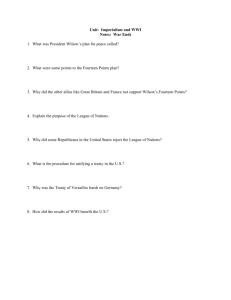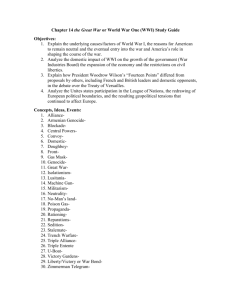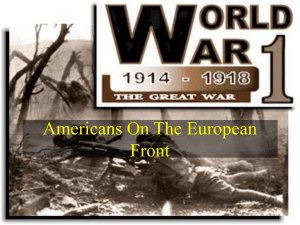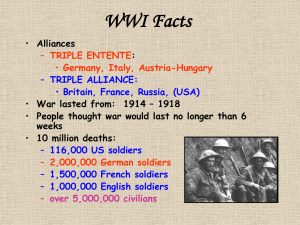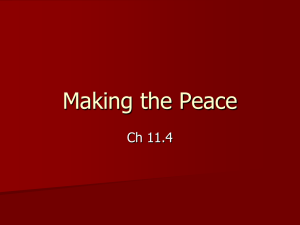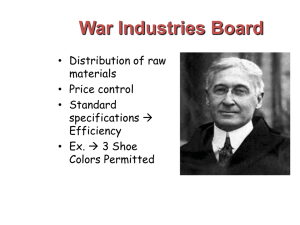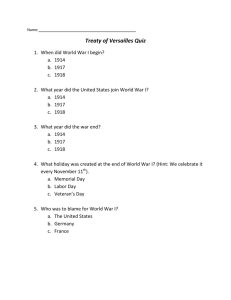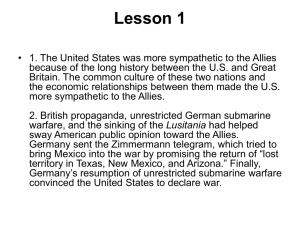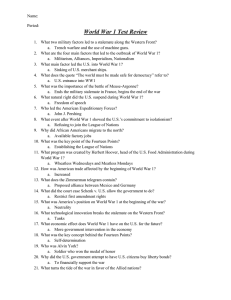A Review of World War I
advertisement
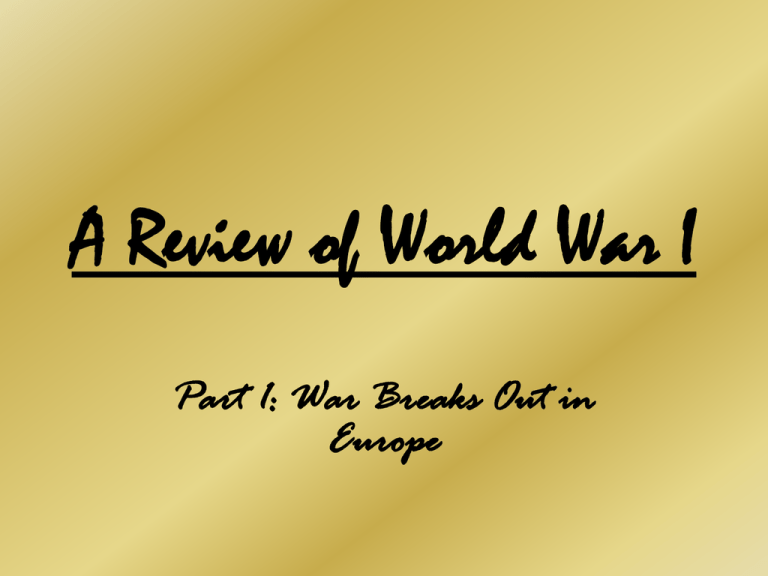
A Review of World War I Part 1: War Breaks Out in Europe I. The Start of WWI A. Archduke Francis Ferdinand of Austria visits Sarajevo on a Serbian national holiday. 1. June 28, 1914 was Serbia’s Independence Day. 2. The day was also a day of mourning to commemorate a military defeat centuries before. B. Ferdinand and his wife are shot and killed by a Serbian nationalist/patriot. C. One month later, Austria declared war on Serbia. One by one, the nations of Europe chose sides and the Great War (WWI) began. II. Causes of World War I A. Imperialism 1. Britain, France, Germany and Italy competed for colonies in Asia and Africa. 2. Germany was jealous of the other imperialist nations because it did not have as many colonies. Germany felt it deserved more. B. Nationalism 1. European nations wanted to prove that their individual nation was the best. 2. They felt that their country’s interests were far more important than the others. This created arrogance! C. Militarism – This is the belief that a nation needs a large military force. European nations were building up their armies and navies during peacetime to show their power to the world. D. Alliances – In 1914, a tangled network of competing alliances bound European nations together. An attack on one nation forced its allies to come to its aid. A small conflict could become a larger war. • • European nations had divided into 2 opposing alliances: The Central Powers – Austria-Hungary, Germany, Bulgaria, and the Ottoman Empire. The Allied Powers (the “Allies”) – Serbia, Russia, France, Great Britain, Italy, and seven other countries. III. New Methods of Warfare A. Trench Warfare (troops huddled in rat infested trenches and fired artillery and machine guns at one another – cost thousands of lives with little gain) B. New Technologies – 1. Tanks (a British invention) 2. Poison gas (burned and blinded soldiers) 3. U-boats or submarines (guns & torpedoes to block trade – sank over 11 million tons of Allied shipping) 4. Airplanes (first major combat used Manfred von Richthofen (the Red Barron) shot down over 80 planes (5+ = Ace) 5. Machine gun (fired 600 bullets a minute) IV. The US Switches from Neutrality to an Ally Power. A. The Germans sink the Lusitania, killing 1,198 people including 128 Americans. 1. It was a British passenger ship. 2. The event turned many Americans against the Germans. B. Zimmermann Telegram 1. A telegram written by a German foreign minister (Arthur Zimmermann) that was intercepted by the British. 2. Germany was trying to persuade Mexico to join the Central Powers. Germany promised to help Mexico get back the colonies it lost to the US in the Mexican-American War. (Texas, New Mexico and Arizona) 3. This news made Americans furious. A Review of World War I continued . . . Part 2: America Joins the Fight I. The Draft Begins A. The draft started so that the government could fulfill its need for troops. (The US had less than 200,000 soldiers.) B. In May 1917, Congress passed the Selective Services Act, which required all males between the ages of 21 and 30 to sign up for military service. By the end of 1918, nearly 3 million men had been drafted. II. The U.S. Enters the War A. By the time the first American troops arrived in June 1917, the Allies had been at war for almost three years. B. The troops helped shift the balance in favor of the allies by giving the other Ally countries a morale boost. C. Americans were proud of the contribution their troops made to the war effort. (About 2 million American soldiers went to France. Around 400,000 African-Americans also served in the armed forces and it was the first time in US history that women served in the military.) III. Armistice Day A. On November 11, 1918 at 11am (the 11th hour of the 11th day of the 11th month) the Germans agreed to an armistice or an end to fighting. (Armistice Day) B. About 8.5 million soldiers (5 million Allied/3.5 million Central Powers) died in the war and about 21 million were wounded. A Review of World War I Continued . . . Part 3: Life on the Home Front I. The Wartime Economy A. War bonds were low interest loans by civilians to the government, meant to be repaid in a number of years. B. The war brought more government control of the economy. To produce such needed war supplies, President Wilson set up the War Industries Board. II. Propaganda A. Propaganda - opinions that are expressed for the purpose of influencing the actions of the people. B. Patriotic propaganda did much to win support for the war; however its antiGerman/anti-foreign focus also fueled prejudice. Suddenly people distrusted anything German. III. Influenza Epidemic A. After the war, in the year 1918, a deadly flu epidemic swept the globe. B. The epidemic started in an army training camp in Kansas and spread rapidly through the air. C. The flu killed more than 20 million people on six continents by the time it disappeared in 1919. A Review of World War I – The Dramatic Conclusion! Part 4: The Legacy of the Great War I. Wilson’s Fourteen Points On January 8, 1918, President Wilson outlined his vision for the postwar world in a plan known as the Fourteen Points. The Fourteen Points were a list of specific proposals for postwar peace. Key goals of the Fourteen Points: * End secret alliances * Encourage free shipping * Remove barriers to trade * Reduce armies and navies * Resolve colonial claims * Support the right of people to choose their own government * Settle border disputes * Establish the League of Nations II. Treaty of Versailles A. Conditions of the Treaty 1. Germany had to pay $33 billion in reparations in order to pay for the destruction that it caused during the war. 2. Germany had to admit its guilt for causing the war. 3. Large empires like Austria-Hungary and the Ottoman Empire were divided up. 4. The League of Nations was created. B. Aftermath of the Treaty 1. Due to stress, Woodrow Wilson suffers a stroke in September 1919. (In 21 days, he traveled almost 10,000 miles and gave over 30 speeches.) 2. The Senate refuses to approve the League of Nations treaty. 3. League of Nations is formed without the US. C. Results of the Treaty 1. It failed to make Europe safer without the US in the League of Nations. 2. Germans grew resentful because of admitting guilt and paying reparations. 3. Germany goes through a Depression. German Economic Problems After WWI • In January 1921, German currency was worth 64 marks to the dollar. • By November 1923, one dollar was worth 4,200,000,000,000 marks. Price of a Loaf of Bread 1918 – just over half a mark 1922 – 163 marks/loaf 1923 (Nov) – 201,000 million marks/loaf • Treaty of Versailles (limitations) Type Amount Allowed Planes 0 Warships 6 Soldiers 100,000 Conscription* Banned *(involuntary labor demanded by an established authority)

